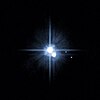Portal:Outer space/Selected article/20
Pluto is the second-largest known dwarf planet in the Solar System and the tenth-largest body observed directly orbiting the Sun. Originally classified as the ninth planet from the Sun, Pluto was recategorized as a dwarf planet and plutoid owing to the discovery that it is only one of several large bodies within the Kuiper belt. Like other members of the belt, it is primarily composed of rock and ice and is relatively small; approximately a fifth the mass of the Earth's Moon and a third its volume. It has an eccentric orbit that takes it from 30 to 49 AU (4.4–7.4 billion km) from the Sun, and is highly inclined with respect to the planets. As a result, Pluto occasionally comes closer to the Sun than the planet Neptune. Pluto has five known moons, the largest being Charon, discovered in 1978, along with Nix and Hydra, discovered in 2005, and the provisionally named S/2011 (134340) 1, discovered in 2011, and S/2012 (134340) 1, discovered in 2012.

